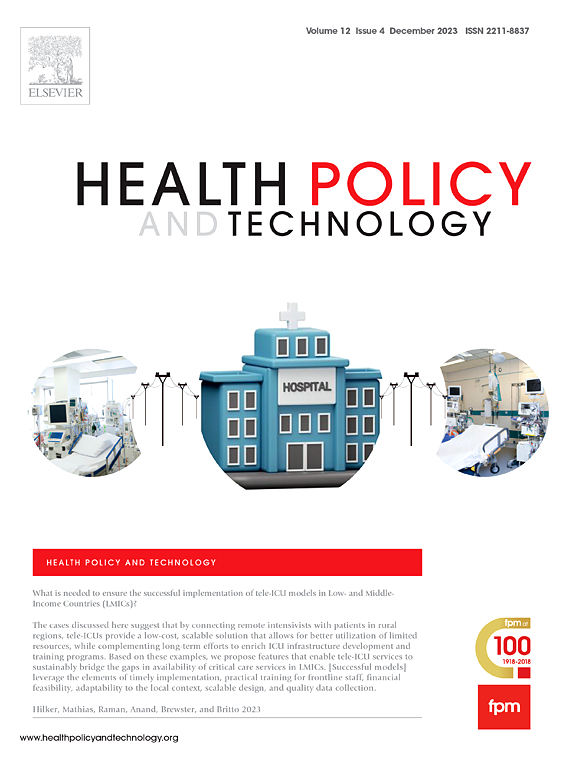Narrative review and bibliometric analysis on infodemics and health misinformation: A trending global issue
IF 3.7
3区 医学
Q1 HEALTH POLICY & SERVICES
引用次数: 0
Abstract
Background
The COVID-19 pandemic exposed how infodemics undermine public health efforts, which subsequently led to the promotion of harmful behaviors. This review aimed to examine major sources of misinformation and explore how demographic and socioeconomic factors affect digital and health literacy, shaping vulnerability to infodemics.
Methods
A narrative review was conducted to synthesize evidence on the pathways, sources, and social determinants of health misinformation. Additionally, a bibliometric analysis was performed using Scopus data from 1997 to 2024, analyzed via Bibliometrix and VOSviewer. The analysis focused on publications related to infodemics and health misinformation on digital platforms, mapping thematic clusters, trends, and keyword co-occurrences.
Results
Mainstream news media, social media, and scientific journals each play a role in disseminating misinformation, exacerbated by time pressure, algorithmic amplification, and inadequate validation processes. Factors attributable to low digital and health literacy include age, education, income, and internet access, which increase vulnerability to misinformation. The bibliometric analysis revealed exponential growth in related research, peaking during the COVID-19 pandemic. Eight dominant research clusters were identified: Health communication and social media; Infodemiology and data analysis; COVID-19 and misinformation; Public and digital health; Vaccine hesitancy; Risk and infodemic management; Conspiracy theories in social media; and Crisis communication.
Conclusion
Infodemics are driven by multi-source digital misinformation and disproportionately affect those with limited literacy. Fact-checking as a mitigation effort can be developed by leveraging artificial intelligence, machine learning, and natural language processing, yet strengthening digital and health literacy remains critical.
关于信息学和卫生错误信息的叙述回顾和文献计量学分析:一个全球趋势问题
2019冠状病毒病大流行暴露了信息流行病如何破坏公共卫生工作,从而导致促进有害行为。本综述旨在检查错误信息的主要来源,并探讨人口和社会经济因素如何影响数字和健康素养,形成对信息流行病的脆弱性。方法对健康错误信息的途径、来源和社会决定因素进行综述。此外,对1997 - 2024年Scopus数据进行文献计量学分析,并通过Bibliometrix和VOSviewer进行分析。分析的重点是与数字平台上的信息流行病和卫生错误信息有关的出版物,绘制专题集群、趋势和关键词共现情况。结果主流新闻媒体、社交媒体和科学期刊都在传播错误信息方面发挥了作用,时间压力、算法放大和不充分的验证过程加剧了这种情况。数字和健康素养低的因素包括年龄、教育、收入和互联网接入,这些因素增加了对错误信息的脆弱性。文献计量学分析显示,相关研究呈指数增长,在COVID-19大流行期间达到顶峰。确定了八个主要研究集群:健康传播和社交媒体;信息流行病学和数据分析;COVID-19和错误信息;公共卫生和数字卫生;疫苗犹豫;风险和信息管理;社交媒体中的阴谋论;危机沟通。结论信息流行病是由多来源的数字错误信息驱动的,对识字率有限的人群影响尤为严重。通过利用人工智能、机器学习和自然语言处理,可以开发事实核查作为缓解措施,但加强数字和健康素养仍然至关重要。
本文章由计算机程序翻译,如有差异,请以英文原文为准。
求助全文
约1分钟内获得全文
求助全文
来源期刊

Health Policy and Technology
Medicine-Health Policy
CiteScore
9.20
自引率
3.30%
发文量
78
审稿时长
88 days
期刊介绍:
Health Policy and Technology (HPT), is the official journal of the Fellowship of Postgraduate Medicine (FPM), a cross-disciplinary journal, which focuses on past, present and future health policy and the role of technology in clinical and non-clinical national and international health environments.
HPT provides a further excellent way for the FPM to continue to make important national and international contributions to development of policy and practice within medicine and related disciplines. The aim of HPT is to publish relevant, timely and accessible articles and commentaries to support policy-makers, health professionals, health technology providers, patient groups and academia interested in health policy and technology.
Topics covered by HPT will include:
- Health technology, including drug discovery, diagnostics, medicines, devices, therapeutic delivery and eHealth systems
- Cross-national comparisons on health policy using evidence-based approaches
- National studies on health policy to determine the outcomes of technology-driven initiatives
- Cross-border eHealth including health tourism
- The digital divide in mobility, access and affordability of healthcare
- Health technology assessment (HTA) methods and tools for evaluating the effectiveness of clinical and non-clinical health technologies
- Health and eHealth indicators and benchmarks (measure/metrics) for understanding the adoption and diffusion of health technologies
- Health and eHealth models and frameworks to support policy-makers and other stakeholders in decision-making
- Stakeholder engagement with health technologies (clinical and patient/citizen buy-in)
- Regulation and health economics
 求助内容:
求助内容: 应助结果提醒方式:
应助结果提醒方式:


